Region of Peel and City of Toronto Remain Top Destination for Millennials in 2020, Even as Many Flee in Search of More Affordable Housing
By: Diana Petramala and Hannah Chan Smyth
January 18, 2021
(PDF file) Print-friendly version available
Statistics Canada released annual population estimates for Canadian major cities (approximated here by census divisions1) for July 1st, 2020. The data shows how the Millennial population in Canada changed between July 1st, 2019 and July 1st, 2020 (referred to as 2019/2020 from here on out). Millennials are defined as those who were born between 1981 and 1996 or were 24 to 39 years of age in 2020.
The data shows that the pandemic curbed the growth in the Millennial population for most major cities across Canada.
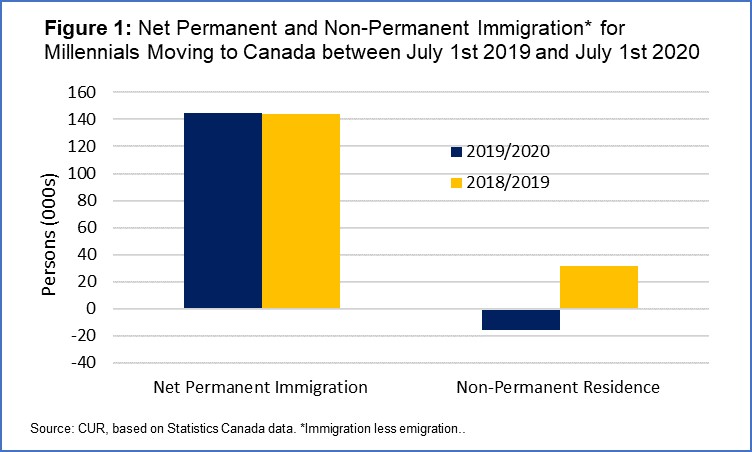
On net, 130,000 Millennials immigrated to Canada in 2020, both on a temporary and permanent basis, down from 175,000 in 2019.
This decline occurred because the pandemic led to fewer non-permanent residents aged 24 to 39 coming to Canada (Figure 1) as online learning at Canada’s major universities and colleges hit the foreign student population.
Net permanent immigration of Millennials into Canada, however, had remained unscathed during that time. A total of 145,000 Millennials immigrated to Canada on a permanent basis, unchanged from the prior year. Meanwhile as media headlines have already highlighted, the data also showed that resident (those already living in Canada) Millennials continued their exodus out of more expensive major cities in 2020, likely in search of more affordable lower density housing.
So, where were they moving to in 2020?
Overall, the Millennial population is still growing the fastest in major cities
The Millennial population grew the fastest in Peel (+15,000), Toronto (+13,000) (refers to the city of Toronto) and Greater Vancouver (9,600) (Figure 2). 2
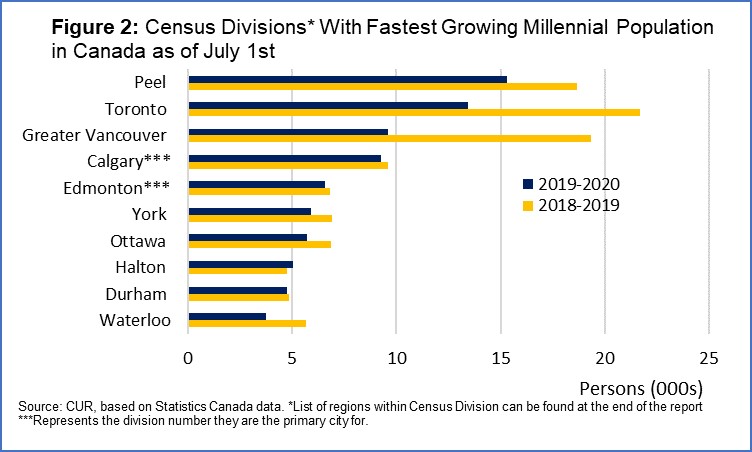
Montreal (-207) was the only major city in Canada to lose Millennial population overall in 2020, after growing by almost 15,000 persons in 2019.
Net permanent immigration boosting the Millennial population in major cities
Net permanent and non-permanent newcomers who did make their way to Canada in 2020 continued to favour Peel (+23,000), Toronto (+22,000) and Montreal (+13,000) (Figure 3).
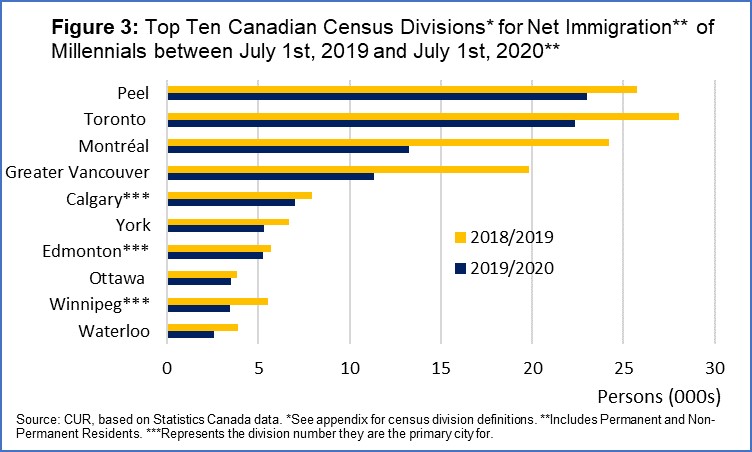
Resident Millennial population continued their exodus out of high cost cities in 2020
The growth in Millennial population among major cities, however, was dampened by those already living in Canada leaving for smaller more affordable cities, a trend that had already taken hold in in the few years prior.
Figures 4a and 4b show that Montreal (-15,000), Toronto (-11,000) and Peel (-8,500) had the greatest net outflow of Canadian Millennials in 2020. These combined inter- and intraprovincial migration estimates are largely unchanged from last year. The data only captures the first four months of the pandemic, so it is still unclear what impact COVID shutdowns have really had on migration trends of Millennials.
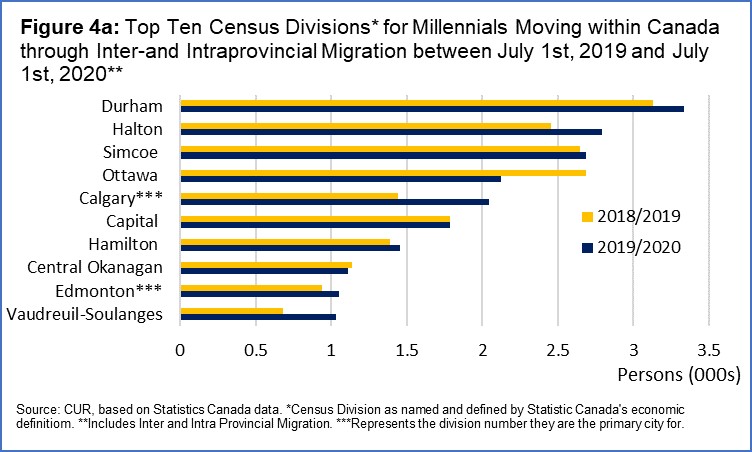
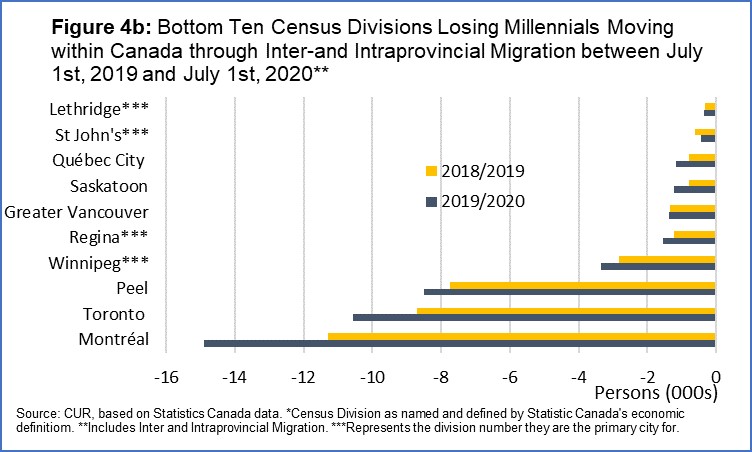
A ranking of cities by change in the Millennial population shows that the top three destinations for those moving around the country were Durham (+3,331), Halton (2,800) and Simcoe (+2,700) – more affordable cities of the Greater Golden Horseshoe.
Ottawa was a top destination for resident Millennials in 2019 but shifted down to the 4th most popular spot in 2020.
Conclusion
Canadian cities remain a magnet for the global Millennial migration. However, resident Millennials moving within the country appear to prefer more affordable regions. These shifts were already underway well before the pandemic.
The only real visible impact of the pandemic up to July 1st, 2020 was to reduce the number of non-permanent residents (students) coming to major cities in Canada.

Appendix
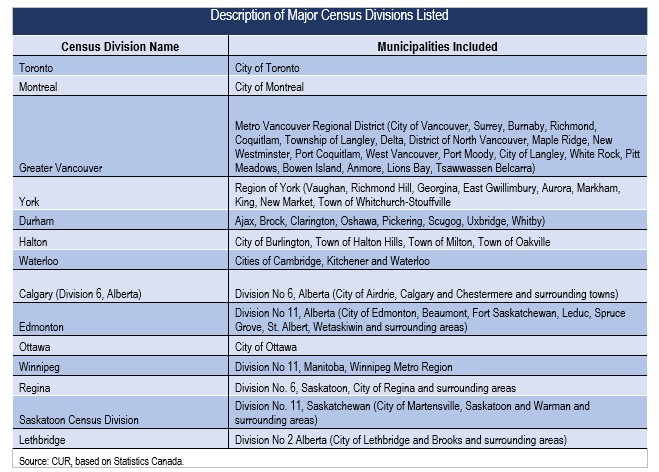

[1] See the appendix for a list of what municipalities are included in census divisions mentioned in this report.
[2] See the appendix for the regions included in census divisions.
Diana Petramala is Senior Economist at Toronto Metropolitan University's Centre for Urban Research and Land Development (CUR) in Toronto.
Hannah Chan Smyth is a Research Assistant at Toronto Metropolitan University's Centre for Urban Research and Land Development (CUR) in Toronto.